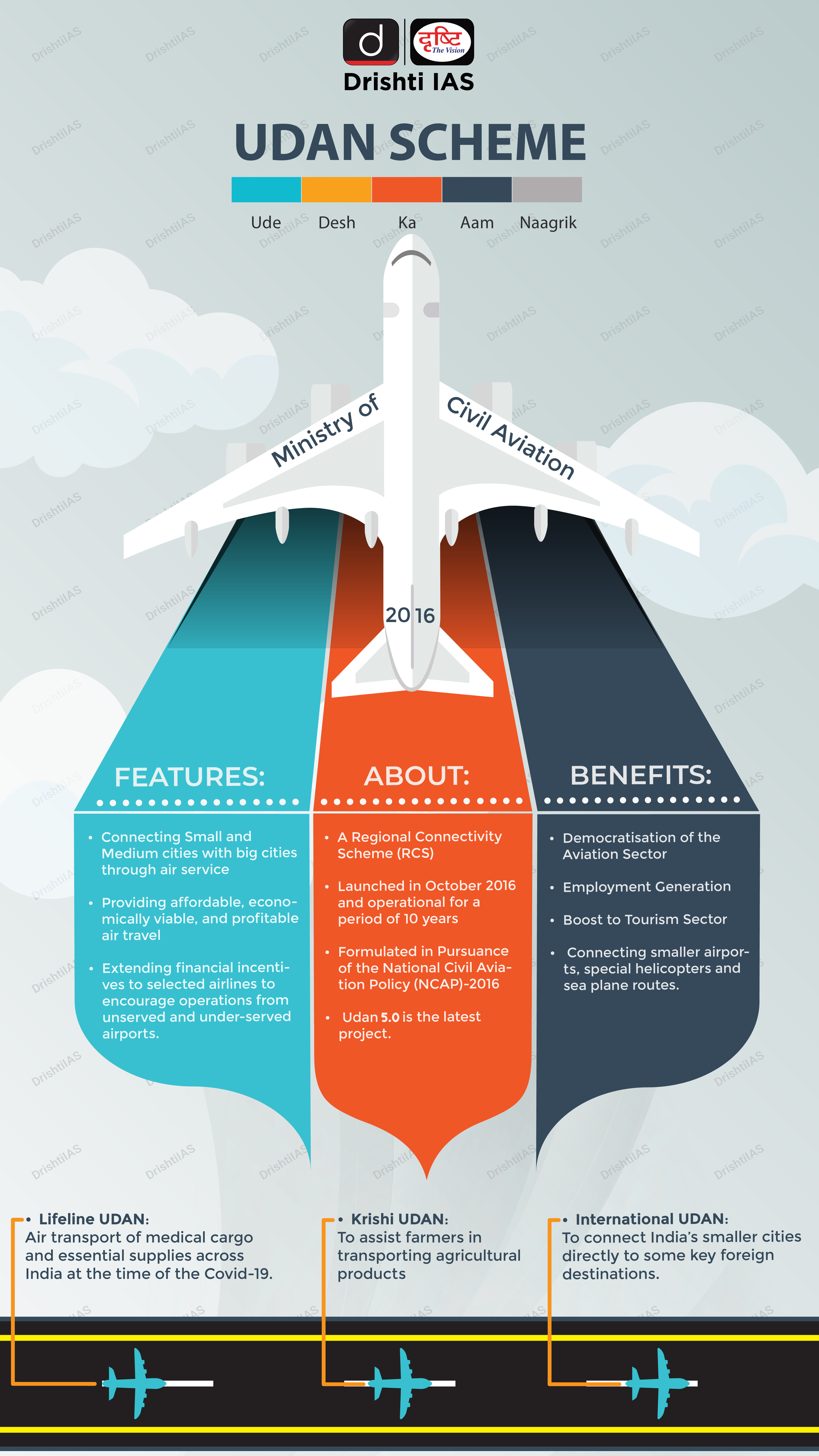UDAN 5.0 Scheme | 24 Apr 2023
For Prelims: UDAN Scheme, UDAN 5.0, Viability Gap Funding (VGF), Regional Connectivity Fund (RCF)
For Mains: UDAN Scheme: Features and achievements, UDAN 5.0
Why in News?
Recently, the government has launched the fifth round of the Regional Connectivity Scheme – UDAN (UDAN 5.0).
What is UDAN (Ude Desh ka Aam Nagrik) Scheme?
- About:
- The scheme was launched by the Ministry of Civil Aviation for regional airport development and regional connectivity enhancement.
- It is a part of the National Civil Aviation Policy 2016.
- The scheme is applicable for a period of 10 years.
- Objectives:
- Improve the air connectivity to remote and regional areas of India.
- Development of remote areas and enhancing trade and commerce and tourism expansion.
- Enable common people to access air travel with affordable rates.
- Employment creation in the aviation sector.
- Key Features:
- Under the scheme, airlines have to cap airfares for 50% of the total seats at Rs. 2,500 per hour of flight.
- This would be achieved through:
- A financial stimulus in the form of concessions from Central and State governments and airport operators and
- Viability Gap Funding (VGF) – A government grant provided to the airlines to bridge the gap between the cost of operations and expected revenue.
- Regional Connectivity Fund (RCF) was created to meet the viability gap funding requirements under the scheme.
- The partner State Governments (other than UTs and NER states where contribution will be 10%) would contribute a 20% share to this fund.
- Previous Phases of the Scheme:
- Phase 1 was launched in 2017, with the objective of connecting underserved and unserved airports in the country.
- Phase 2 was launched in 2018, with the aim of expanding air connectivity to more remote and inaccessible parts of the country.
- Phase 3 was launched in November 2018, with the focus on enhancing air connectivity to hilly and remote regions of the country.
- Phase 4 of the UDAN scheme was launched in December 2019, with a focus on connecting islands and other remote areas of the country.
- Key Features of UDAN 5.0:
- It focuses on Category-2 (20-80 seats) and Category-3 (>80 seats) aircrafts.
- There is no restriction on the distance between the origin and the destination of the flight.
- VGF to be provided will be capped at 600 km stage length for both Priority and Non-Priority areas; earlier capped at 500 km.
- No predetermined routes would be offered; only Network and Individual Route Proposal proposed by airlines will be considered.
- The same route would not be awarded to a single airline more than once, whether in different networks or in the same network.
- Exclusivity of operation provided to an airline will be withdrawn if the average quarterly Passenger Load Factor (PLF) is higher than 75% for four continuous quarters.
- This has been done to prevent exploitation of the monopoly on a route.
- Airlines would be required to commence operations within 4 months of the award of the route; earlier this deadline was 6 months.
- Novation process for routes from one operator to another has been simplified and incentivized.
- Novation - The process of substituting an existing contract with a replacement contract, where the contracting parties reach a consensus.
What are Achievements under UDAN Scheme?
(As per the data released in Aug 2022 by the Ministry of Civil Aviation)
- The scheme has also been able to provide a fair amount of air connectivity to Tier-2 and Tier-3 cities at affordable airfares and has transformed the way travelling was done earlier.
- The number of operational airports has gone up to 141 from 74 in 2014.
- 68 underserved/unserved destinations which include 58 Airports, 8 Heliports & 2 Water Aerodromes have been connected under UDAN scheme.
- With 425 new routes initiated, UDAN has provided air connectivity to more than 29 States/ UTs across the country.
- More than one crore passengers have availed the benefits of this scheme.
UPSC Civil Services Examination Previous Year Question (PYQ)
Q. Examine the development of Airports in India through joint ventures under Public–Private Partnership (PPP) model. What are the challenges faced by the authorities in this regard? (2017)

